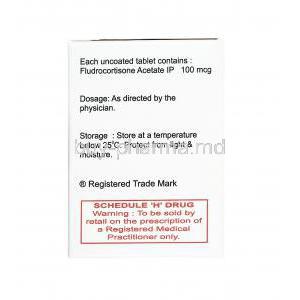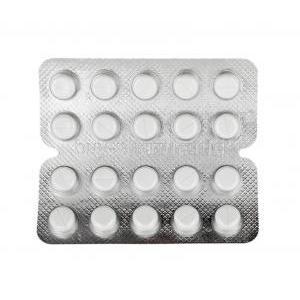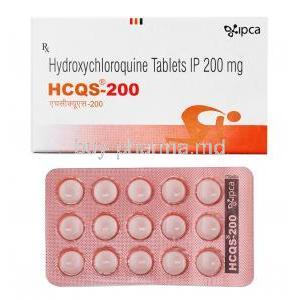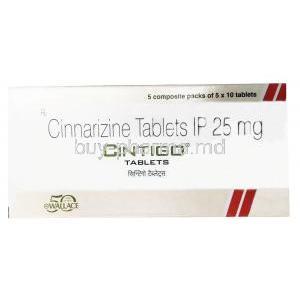Introduction to Floricot (Fludrocortisone Acetate)
Overview of Floricot as a Synthetic Corticosteroid
Floricot, containing fludrocortisone acetate, is a potent synthetic corticosteroid with pronounced mineralocorticoid activity. It is primarily prescribed to restore sodium balance, stabilize blood pressure, and compensate for deficiencies in natural adrenal hormones. Unlike glucocorticoids, which influence metabolism and immune responses, Floricot focuses on regulating fluid and electrolyte equilibrium.
Therapeutic Classification and Historical Development
This medication belongs to the class of mineralocorticoid replacements, designed to emulate the effects of aldosterone. Since its introduction in the mid-20th century, fludrocortisone acetate has remained a cornerstone in treating adrenal insufficiency and related conditions. Its enduring relevance stems from its reliability, precise mechanism, and the absence of equally effective alternatives in certain disorders.
General Role in Mineralocorticoid Replacement Therapy
In mineralocorticoid replacement therapy, Floricot plays a vital role by maintaining plasma sodium concentration, reducing potassium overload, and supporting hemodynamic stability. Patients who cannot produce sufficient endogenous mineralocorticoids rely on it to avoid life-threatening crises such as severe hypotension or electrolyte imbalance.
Composition and Formulation
Active Ingredient: Fludrocortisone Acetate
The therapeutic agent within Floricot is fludrocortisone acetate, a fluorinated derivative of hydrocortisone. This chemical modification enhances its mineralocorticoid potency, allowing small doses to achieve substantial physiological effects.
Available Strengths and Dosage Forms
Floricot is typically supplied as oral tablets, most commonly in strengths of 0.1 mg. This standardized dosing simplifies titration and helps physicians adjust therapy according to individual patient responses.
Inactive Excipients and Their Role
Alongside the active molecule, the formulation includes inactive excipients such as starches, stabilizers, and binding agents. These substances do not alter therapeutic effects but ensure tablet stability, disintegration, and predictable absorption in the gastrointestinal tract.
Mechanism of Action: How Floricot Works
Mineralocorticoid Activity and Sodium Retention
Fludrocortisone binds to mineralocorticoid receptors in the distal renal tubules. This action stimulates sodium reabsorption and water retention, helping to expand extracellular fluid volume. By this process, blood pressure rises and circulatory stability is preserved.
Effects on Potassium Excretion and Fluid Balance
As sodium is retained, potassium is excreted. This dual effect maintains osmotic equilibrium but requires vigilant monitoring to prevent hypokalemia. Correct balance between these electrolytes is crucial for neuromuscular function and cardiac rhythm stability.
Influence on Adrenal Function and Blood Pressure Regulation
By compensating for adrenal underproduction of aldosterone, Floricot directly supports physiological blood pressure regulation. It prevents orthostatic collapse, sustains renal perfusion, and ensures adequate vascular tone even under stress or illness.
Approved Medical Uses
Primary Adrenal Insufficiency (Addison’s Disease)
In Addison’s disease, the adrenal cortex fails to produce sufficient hormones. Floricot is indispensable for restoring mineralocorticoid activity, often used alongside glucocorticoids such as hydrocortisone to provide complete hormonal replacement therapy.
Congenital Adrenal Hyperplasia
Children born with congenital adrenal hyperplasia often suffer from impaired cortisol and aldosterone synthesis. Fludrocortisone acetate helps normalize salt balance, preventing dehydration, hypotension, and potentially fatal adrenal crises in infancy and childhood.
Salt-Losing Adrenogenital Disorders
Certain genetic disorders cause excessive salt loss, leading to dehydration and electrolyte abnormalities. Floricot mitigates this risk by enhancing sodium retention, thereby maintaining homeostasis and preventing recurrent hospitalizations.
Orthostatic Hypotension Management
In patients who develop sudden drops in blood pressure upon standing, Floricot strengthens vascular tone through increased sodium and fluid retention. This effect helps reduce dizziness, fainting, and fatigue related to autonomic dysfunction.
Off-Label Uses
Management of Refractory Postural Tachycardia Syndrome (POTS)
Some patients with POTS benefit from Floricot’s blood volume expansion, which counteracts excessive heart rate increases upon standing. While not universally effective, it remains a therapeutic option for individuals unresponsive to lifestyle modification alone.
Supportive Therapy for Chronic Fatigue Syndrome with Orthostatic Intolerance
In cases of chronic fatigue syndrome complicated by orthostatic intolerance, fludrocortisone acetate may offer symptomatic relief by improving circulatory dynamics. Its use in this context remains experimental but has shown promise in selected clinical settings.
Use in Severe Hypotension Resistant to Other Treatments
Patients with persistent, treatment-resistant hypotension may receive Floricot as adjunctive therapy. By promoting vascular filling, it can enhance the efficacy of other pharmacological agents used to stabilize blood pressure.
Potential Role in Cerebral Salt Wasting in Neurological Conditions
In neurological disorders such as subarachnoid hemorrhage, patients sometimes develop cerebral salt wasting with profound hyponatremia. Off-label administration of Floricot helps counteract this condition, though careful monitoring is required to prevent fluid overload.
Dosage and Administration
Standard Dosage Recommendations for Adults
In adults, the typical starting dose of Floricot (fludrocortisone acetate) is 0.1 mg daily, administered orally. The dosage may be adjusted within a range of 0.05 to 0.2 mg per day depending on individual response. A minimal effective dose should always be sought to reduce adverse effects while maintaining therapeutic efficacy.
Titration and Dose Adjustment Strategies
Titration is performed based on blood pressure, plasma renin activity, and serum electrolyte levels. Physicians may reduce the dose in cases of edema or hypertension, or increase it in settings of persistent hypotension. Fine adjustments are often required in patients with fluctuating physiological needs such as during illness or stress.
Special Instructions for Morning Administration
Morning administration is preferred as it mimics the body’s natural circadian rhythm of corticosteroid release. This practice helps reduce disturbances in sleep cycles and minimizes adverse endocrine feedback.
Duration of Therapy and Monitoring Requirements
Most patients require lifelong therapy, particularly those with Addison’s disease or congenital adrenal hyperplasia. Regular monitoring of blood pressure, serum sodium, potassium, and weight is essential. Long-term follow-up also includes cardiovascular risk assessment and periodic ophthalmologic evaluation.
Administration in Special Populations
Administration to Elderly Patients
Elderly patients often exhibit altered pharmacokinetics, leading to increased sensitivity to mineralocorticoid effects. This raises the risk of hypertension, edema, and cardiac complications.
- Heightened fall risk due to orthostatic blood pressure changes
- Requirement for close monitoring of renal function and electrolyte balance
- Possible dose reductions compared with younger adults
Administration to Pregnant Women and Nursing Mothers
Fludrocortisone acetate is generally classified in pregnancy category C, indicating that risk to the fetus cannot be ruled out. Data on teratogenicity are limited, but prolonged exposure may affect intrauterine growth.
- Potential for intrauterine growth restriction
- Excretion in breast milk with possible neonatal effects
- Clinical use reserved for cases where maternal benefit outweighs potential risks
During pregnancy, careful monitoring of blood pressure, weight, and electrolytes is vital. Dosage adjustments may be required as pregnancy progresses due to physiologic fluid shifts.
Administration to Children
Floricot is prescribed for pediatric patients with adrenal insufficiency and congenital adrenal hyperplasia. Therapy in children requires precise dose individualization to maintain electrolyte balance without impairing growth.
- Monitoring growth velocity to avoid stunted development
- Routine blood electrolyte testing
- Careful adjustment based on clinical status and laboratory results
Side Effects of Floricot
Common Side Effects
Frequent side effects include mild but noticeable changes in blood pressure and fluid balance:
- Hypertension and peripheral edema
- Headache, dizziness, or mood fluctuations
- Gastrointestinal upset such as nausea or bloating
- Weight gain due to fluid retention and sodium imbalance
Serious and Less Common Side Effects
Though less frequent, serious complications may occur:
- Exacerbation of congestive heart failure
- Severe hypokalemia leading to muscle weakness or arrhythmias
- Metabolic alkalosis
- Glaucoma, cataracts, and other visual disturbances
- Increased risk of infection due to immunomodulatory effects
Drug Interactions
Interaction with Diuretics and Antihypertensives
Concurrent use with diuretics may intensify electrolyte disturbances, particularly hypokalemia. Antihypertensives may have diminished effectiveness due to Floricot’s blood pressure–raising effects.
Interaction with Digoxin and Cardiac Glycosides
Hypokalemia induced by Floricot may amplify the cardiotoxicity of digoxin, heightening the risk of arrhythmias. Regular potassium monitoring is critical when these drugs are used together.
Interactions with Anticoagulants and Antidiabetic Drugs
Fludrocortisone can alter the effectiveness of anticoagulants and may affect glycemic control in patients on insulin or oral hypoglycemics. Dose adjustments of these agents may be necessary.
Corticosteroid Synergy and Risk of Enhanced Side Effects
When combined with glucocorticoids, the risk of systemic side effects such as osteoporosis, weight gain, and immunosuppression increases. Careful balancing of therapy is required.
Warnings and Important Precautions
- Floricot may mask infection symptoms, delaying diagnosis and treatment.
- Psychiatric disturbances including mood swings, anxiety, or depression may occur.
- Patients with pre-existing cardiovascular disease require special caution due to fluid retention and hypertension.
- Renal impairment patients must be closely observed to prevent worsening electrolyte imbalance.
Contraindications
- Hypersensitivity to fludrocortisone or excipients
- Systemic fungal infections
- Severe, uncontrolled hypertension
- Decompensated congestive heart failure
- Active peptic ulcer disease or gastrointestinal bleeding
Careful Administration Considerations
To prevent adrenal crisis, gradual dose reduction is mandatory when discontinuing therapy. Patients must undergo regular monitoring of blood pressure, electrolytes, and body weight. Long-term therapy carries additional risks including osteoporosis, muscular atrophy, and metabolic changes, necessitating periodic reassessment of treatment necessity.
Overdosage and Toxicity
Clinical Manifestations of Overdose
Excessive ingestion can lead to pronounced hypertension, generalized edema, severe hypokalemia, and cardiac arrhythmias. Neurological symptoms such as confusion or seizures may also develop.
Emergency Management and Supportive Therapy
There is no specific antidote. Management is symptomatic, with emphasis on discontinuation of the drug, control of blood pressure, and correction of fluid balance. Intensive care may be necessary in severe cases.
Role of Electrolyte Correction and Fluid Management
Electrolyte replenishment, especially potassium supplementation, is vital. Fluid restriction and diuretics may be used under strict supervision to manage edema.
Handling and Storage Precautions
- Store tablets at controlled room temperature, ideally between 20°C and 25°C.
- Protect from direct light and excessive moisture.
- Follow safe handling practices in clinical environments to prevent contamination.
- Dispose of expired or unused medication according to pharmaceutical waste guidelines.
Floricot, Fludrocortisone Acetate FAQ
- What is the use of Floricot Tablet?
- Who should not take floricot tablets?
- Is fludrocortisone used for low blood pressure?
- What is the difference between fludrocortisone and fludrocortisone acetate?
- What are the disadvantages of fludrocortisone?
- What are the benefits of taking fludrocortisone?
- How long does it take for fludrocortisone to increase blood pressure?
- What to avoid while taking fludrocortisone?
- How long can you take fludrocortisone?
- Does fludrocortisone increase blood sugar?
- Can fludrocortisone affect vision?
- When is the best time to take fludrocortisone?
- What happens if you don't take fludrocortisone?
- Does fludrocortisone help with dizziness?
- What is the most common adverse effect of fludrocortisone?
- Does fludrocortisone make you urinate more?
- What is the diet for fludrocortisone?
- Can you take fludrocortisone and amLODIPine together?
- Does fludrocortisone help build muscle?
- Can fludrocortisone make you shaky?
- Does fludrocortisone affect the kidneys?
- Is fludrocortisone the same as prednisone?
- Does fludrocortisone help with inflammation?
- Can fludrocortisone cause brain fog?
- Can you take paracetamol with fludrocortisone?
- Can I take fludrocortisone every other day?
- Is fludrocortisone safe for elderly people?
- Does fludrocortisone affect sleep?
What is the use of Floricot Tablet?
Floricot Tablet is utilized for treating Addison's disease (insufficient production of natural steroid hormones by the adrenal glands). It also helps in rectifying electrolyte imbalances linked to Addison's disease.
Who should not take floricot tablets?
- if you have an allergy to any corticosteroids or any of the components in Floricot Tablet.
- If you are pregnant, planning to become pregnant, or breastfeeding.
Is fludrocortisone used for low blood pressure?
Fludrocortisone is regarded as a first- or second-line medication for treating orthostatic hypotension.
What is the difference between fludrocortisone and fludrocortisone acetate?
Fludrocortisone is a synthetic adrenal steroid that exhibits strong mineralocorticoid properties and has minimal glucocorticoid effects.
What are the disadvantages of fludrocortisone?
- Abdominal pain
- Agitation or combativeness
- Anxiety
- Back or rib pain
- Blindness
- Bloating
- Dark, sticky stools
- Blurred vision.
What are the benefits of taking fludrocortisone?
Fludrocortisone treats low cortisol levels in the body (adrenal insufficiency). It functions by substituting for cortisol that the body typically produces. Cortisol is a hormone that is crucial in how the body reacts to stress, illness, and injury.
How long does it take for fludrocortisone to increase blood pressure?
30 minutes to 1 hour
What to avoid while taking fludrocortisone?
Avoid close contact with individuals who are ill or have recently recovered, particularly from chickenpox or measles.
How long can you take fludrocortisone?
3 weeks
Does fludrocortisone increase blood sugar?
Yes
Can fludrocortisone affect vision?
Fludrocortisone can lead to cataracts or glaucoma, potentially resulting in blindness.
When is the best time to take fludrocortisone?
After breakfast
What happens if you don't take fludrocortisone?
- loss of appetite
- nausea
- vomiting
- fatigue
- confusion
- headache
- fever
- muscle and joint pain
- peeling skin
- weight loss
Does fludrocortisone help with dizziness?
No
What is the most common adverse effect of fludrocortisone?
- Swollen neck veins
- Tearing eyes
- Unexplained weight loss
- Unusual fatigue or weakness
- Changes in vision
- Weight gain
- Wheezing
- Yellowing of the eyes or skin.
Does fludrocortisone make you urinate more?
Yes
What is the diet for fludrocortisone?
- Low-sodium
- Low-salt
- Potassium-rich
- High-protein diet
Can you take fludrocortisone and amLODIPine together?
Fludrocortisone might diminish the ability of amlodipine to lower blood pressure.
Does fludrocortisone help build muscle?
No
Can fludrocortisone make you shaky?
Yes
Does fludrocortisone affect the kidneys?
Fludrocortisone causes the kidneys to hold onto sodium and excrete potassium in the urine.
Is fludrocortisone the same as prednisone?
Fludrocortisone is primarily utilized for its mineralocorticoid properties, while hydrocortisone, cortisone, prednisone, and prednisolone are employed for their glucocorticoid effects.
Does fludrocortisone help with inflammation?
Yes
Can fludrocortisone cause brain fog?
Yes
Can you take paracetamol with fludrocortisone?
Yes
Can I take fludrocortisone every other day?
No
Is fludrocortisone safe for elderly people?
Poorly tolerated over time in older patients with hypotensive conditions.
Does fludrocortisone affect sleep?
Fludrocortisone may lead to sleep disturbances as a side effect.























